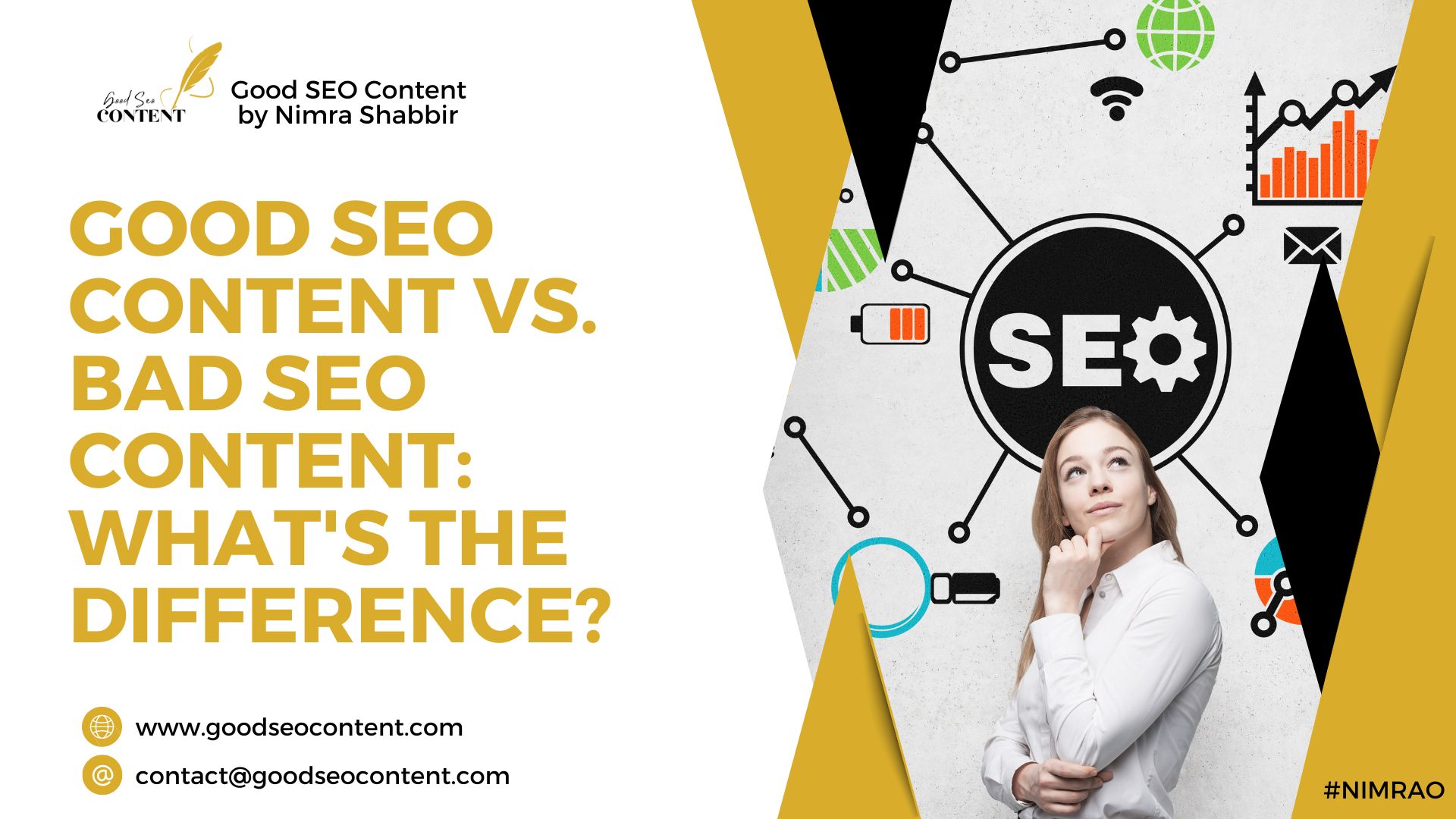Table of Contents
In the digital age, the significance of creating good SEO content cannot be overstated. As businesses strive to enhance their online presence, understanding the nuances between effective and ineffective SEO content becomes crucial. This article delves into the differences, helping you refine your SEO content strategy and ensuring your content stands out in the crowded digital landscape.
Defining Good SEO Content
Good SEO content is a blend of quality writing and strategic optimization. It not only appeals to search engines but also provides value to readers. Here are the key characteristics of good SEO content:
Read: Video content for marketing

1. High-Quality Content Creation
Good SEO content starts with quality. This means well-researched, informative, and engaging content that addresses the needs and interests of your audience. Quality content establishes your authority in your niche and encourages readers to spend more time on your site.
2. SEO Friendly Content Writing
Effective SEO content seamlessly integrates keywords without compromising readability. Keywords should appear naturally within the content, titles, headers, and meta descriptions, enhancing the likelihood of being discovered by search engines.
3. Search Engine Friendly Content
Creating search engine friendly content involves following best practices such as using proper header tags (H1, H2, H3), including alt text for images, and ensuring the content is mobile-friendly. This approach makes it easier for search engines to crawl and index your site.
Read: Benefits or influencer marketing

4. Content Optimization Techniques
Good SEO content is optimized for both search engines and readers. This includes using relevant keywords, optimizing meta tags, and ensuring fast page load times. Tools like Google Analytics can help track performance and guide further optimization.
5. Creating Engaging Content
Engaging content keeps readers hooked. It uses compelling headlines, storytelling, and multimedia elements to maintain interest. Engaging content also encourages social shares and backlinks, boosting your site’s SEO.
6. Content Marketing Strategy
A robust content marketing strategy is essential for good SEO content. This involves planning, creating, distributing, and analyzing content to attract and retain a clearly defined audience. A strategic approach ensures consistency and alignment with business goals.
Read: Boosting online visibility for small businesses

Characteristics of Bad SEO Content
Bad SEO content, on the other hand, falls short in several areas. It fails to meet the standards set by search engines and users, leading to poor performance and low engagement. Here are some common pitfalls:
1. Keyword Stuffing
One of the most detrimental practices is keyword stuffing. This involves overloading content with keywords in an attempt to manipulate search engine rankings. Not only does this make the content unreadable, but search engines also penalize such practices.
2. Thin Content
Thin content offers little to no value to the reader. It is often too short, lacks depth, and fails to address the reader’s query comprehensively. Search engines favor in-depth, informative content over thin content.
Read: How to create the SEO content strategy

3. Duplicate Content
Duplicate content refers to identical or very similar content appearing on multiple pages of a site or across different sites. This confuses search engines and dilutes the value of the content, negatively impacting SEO performance.
4. Lack of Content Optimization
Bad SEO content often lacks proper optimization. This includes missing meta tags, poor use of headers, unoptimized images, and slow page load times. Such content is less likely to rank well on search engines.
5. Poor Readability
Content that is difficult to read and understand drives readers away. This includes large blocks of text, complex sentences, and lack of structure. Good SEO content is easy to read and understand, catering to a broad audience.
Read: Top 10 SEO techniques
6. Ignoring User Experience
Bad SEO content neglects the user experience. This includes poor formatting, broken links, and intrusive ads. A positive user experience is crucial for retaining visitors and encouraging them to explore more of your site.
Implementing a Winning SEO Content Strategy
To ensure your content aligns with SEO best practices, consider these content optimization tips:
1. Conduct Keyword Research
Identify relevant keywords with low difficulty and high search volume. Use tools like Google Keyword Planner or Ahrefs to find keywords that align with your audience’s search intent.
2. Optimize On-Page Elements
Ensure that titles, headers, meta descriptions, and images are optimized. Use primary and secondary keywords naturally throughout your content.
Read: Create Brand awareness with SEO

3. Focus on Quality and Relevance
Produce content that is informative, well-researched, and relevant to your audience. Aim for a balance between keyword optimization and providing genuine value to readers.
4. Use Engaging Formats
Incorporate different content formats such as blogs, videos, infographics, and podcasts to keep your audience engaged. Diverse content formats can cater to different preferences and increase user engagement.
5. Monitor and Analyze Performance
Regularly monitor your content’s performance using tools like Google Analytics. Analyze metrics such as page views, bounce rates, and conversion rates to identify areas for improvement.
6. Update and Repurpose Content
Keep your content fresh and up-to-date. Regularly update existing content to ensure it remains relevant. Repurpose content into different formats to reach a broader audience.

In order to get professional SEO consultation advices contact NimRao at contact@goodseocontent.com or you can catch me up at instagram (@nimra_shabbir01), Linkedin (Nimra Shabbir). I would like to consult about your SEO needs so make sure to leave a message!
Conclusion
The difference between good and bad SEO content lies in the balance between meeting search engine criteria and providing value to readers. By focusing on quality, relevance, and strategic optimization, you can create content that not only ranks well but also engages and retains your audience. Implementing a robust content marketing strategy and following content marketing best practices will ensure your content contributes positively to your overall SEO efforts.
In summary, good SEO content is all about striking the right balance between technical optimization and valuable, engaging content. By adhering to these principles and continuously refining your approach, you can achieve long-term success in the digital landscape.
The primary difference lies in quality and optimization. Good SEO content is well-researched, informative, and engaging, providing value to the reader while being optimized for search engines. It uses keywords naturally, adheres to SEO best practices, and enhances the user experience. In contrast, bad SEO content often involves keyword stuffing, lacks depth, is poorly optimized, and provides little to no value to readers.
To ensure your content is SEO-friendly, follow these steps:
- Conduct thorough keyword research to find relevant keywords with low difficulty and high search volume.
- Integrate keywords naturally into your content, including titles, headers, and meta descriptions.
- Optimize on-page elements such as images, alt text, and internal links.
- Focus on creating high-quality, engaging content that provides value to readers.
- Ensure your website is mobile-friendly and has fast loading times.
- Regularly update and repurpose content to keep it fresh and relevant.
Common mistakes that lead to bad SEO content include:
- Keyword Stuffing: Overloading content with keywords, making it unreadable.
- Thin Content: Creating content that lacks depth and fails to address the reader’s query comprehensively.
- Duplicate Content: Posting identical or very similar content on multiple pages or sites.
- Poor Readability: Writing content that is difficult to read and understand.
- Lack of Optimization: Failing to optimize meta tags, headers, images, and page load times.
- Ignoring User Experience: Neglecting formatting, using broken links, and placing intrusive ads.
Regular updates are essential for maintaining good SEO. Aim to review and update your content at least every 6 to 12 months. This ensures your information remains accurate and relevant, aligns with current SEO best practices, and continues to meet the needs of your audience. Additionally, consider repurposing high-performing content into different formats to extend its reach and effectiveness.


My brother recommended I might like this web site He was totally right This post actually made my day You cannt imagine just how much time I had spent for this information Thanks